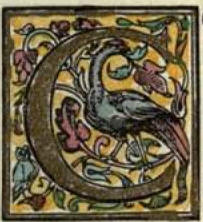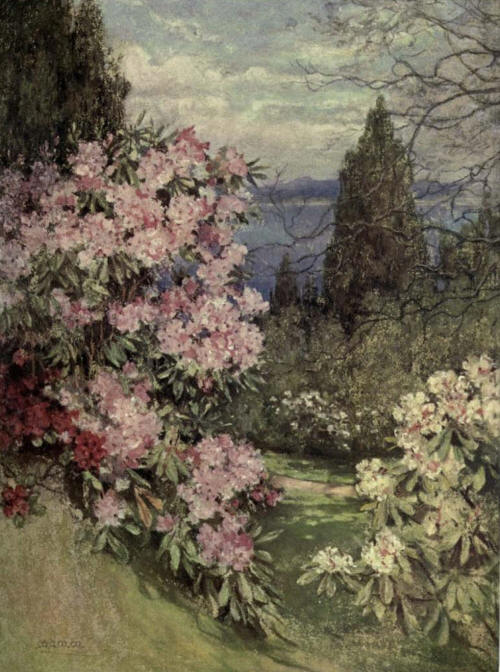|
 AELO
FAVENTEŚweather permitting the shores of Clyde and the Kyles of Bute
present constantly shifting scenes of beauty to those who go down to the
sea in the fine ships the Iona, the Columba or the Grenadier; but of the
many thousands who take their pleasure in this way every summer, what a
small percentage suspect what treasures are stored in the sloping woods
on either hand. No English gardener will believe, till he has seen for
himself, what luxuriant growth of tender exotics can be produced on the
west coast of Scotland, wherever it is possible to provide shelter from
Atlantic gales. The fierce winds and mighty rollers that waste their
fury for weeks together on the rock-bound western isles, can work no
ruin in the long, narrow fjords which intersect the mainland. I was
prepared, therefore, to find evidence of a very gentle climate along the
shores of Loch Fyne; but what I found exceeded all anticipation. AELO
FAVENTEŚweather permitting the shores of Clyde and the Kyles of Bute
present constantly shifting scenes of beauty to those who go down to the
sea in the fine ships the Iona, the Columba or the Grenadier; but of the
many thousands who take their pleasure in this way every summer, what a
small percentage suspect what treasures are stored in the sloping woods
on either hand. No English gardener will believe, till he has seen for
himself, what luxuriant growth of tender exotics can be produced on the
west coast of Scotland, wherever it is possible to provide shelter from
Atlantic gales. The fierce winds and mighty rollers that waste their
fury for weeks together on the rock-bound western isles, can work no
ruin in the long, narrow fjords which intersect the mainland. I was
prepared, therefore, to find evidence of a very gentle climate along the
shores of Loch Fyne; but what I found exceeded all anticipation.
If you look at the map of
Argyll, you will see that the promontory of Cantyre, a finger of land
about forty miles long and, on an average, not more than seven miles
wide, only escapes severance from the mainland by means of a strip of
ground a mile wide. When Malcolm Canmore ceded to Magnus Barefoot, King
of Norway, all the islands "between which and the mainland he could pass
in a galley with its rudder shipped," the Northman secured Cantyre by
running his craft ashore at the head of West Loch Tarbert, and causing
it to be drawn on rollers across the isthmus to Loch Fyne, with his own
hand on the tiller. Three hundred years later, Robert the Bruce repeated
the feat, in token of his lordship of the Isles, and built a keep at the
eastern end of the portage, which still presides, grim and time-worn,
over the snug little town of Tarbert, with its tortuous, but profound,
harbour. These incidents are commemorated in the name of the place,
Tarbert signifying "boat draft" or portage, from the Gaelic taruinn bada.
North of the isthmus lies
the district of Knapdale, near the southern extremity of which is Mr.
George Campbell's fine demesne of Stonefield, facing the blue waters of
Loch Fyne on the east and sheltered from prevailing winds by high ground
on the south-west and north-west. To enumerate half the rare forms of
vegetation which thrive among the ample woodland of Stonefield would
fill a very long chapter. Readers will kindly be content with the bare
notes of a visit paid to these grounds in mid-April.

The first things to
attract attention are some specimens of Eucalyptus gunni, the tallest of
which is 80 feet high, and 5 feet in circumference at 4 feet from the
ground, with a beautiful clean bole of 25 feet. The blue gum (E.
globulus), though perfectly hardy against frost, grows such length of
soft wood that it constantly gets broken by the wind. Probably if
planted in mass, the trees would protect each other, but E. gunni is
evidently a preferable species.
Near the foot of one of
these gum-trees is a bush of the Chilian Desfontainea spinosa, a mass of
rich myrtle green, 75 feet in circumference and 14 feet high. It has
been severely cut in on one side, to prevent it overspreading a gravel
path, and, when thickly set with its scarlet and yellow blossoms, must
indeed be "a sight for sair e'en." Another shrub, from the southern
hemisphere, Griselinia littoralis from New Zealand, here assumes the
proportions of a small tree, 30 feet high. Mitraria coccinea, seldom
seen in British gardens, and, when seen, usually of very modest
dimensions, has grown so dense and spread so wide that last year a hen
pheasant chose a bush of it for her nesting place. Philesia buxifolia
rivals it in size; Abutilon vitifolium, 15 feet high,
Myrtus (Eugenia)
apiculata and Cordyline Australis each 20 feet high, Escallonia rubra
with a stem girth of 2 feet, Buddleia Colvillei 9 feet high, are a few
of the things most worth noting before passing on to examine the
rhododendrons, which are the special glory of the place. By the by, why
can we not drop that cumbrous polysyllable and adopt the American name
"rose bay" or "rose laurel"?
The presence of these
fine plants dates from the 'forties, when Sir Joseph Hooker, with
youthful ardour, was revelling in the floral wealth of the Himalayas.
Dr. Campbell, of the family of Oronsay, who founded the sanatorium of
Darjeeling in 1835, shared Hooker's enthusiasm, and sent home quantities
of seed, some of which found its way to Stonefield. A noble crop has
sprung from it. Here are trees of Rhododendron arboreum 30 feet high
with blood-red, pink or white blossoms, and with stems thicker than any
wood-nymph's waist; R. Falconeri 25 feet high, carrying among its great
felted leaves between 200 and 300 trusses of waxy bells; R. eximium,
probably a local variety of the last-named, loaded with bloom; R.
barbatuin, the bearded rose-bay, in both varieties, one a month later in
bloom than the other, both excelling all their kind in the glow of
blood-red flowers. R. Thomsoni stands 15 feet high and 20 feet in
diameter, and among other treasures may be mentioned Rhododendron grande
(argenteum), a shy flowerer, but worth growing for its splendid foliage
alone; R. niveum with purple flowers and leaves lined with white peau de
Suede R. Hodgsoni with leaves like Falconeri but with rosy flowers, R.
fragrantissimum,, campanulatum and ciliatum, all revelling in conditions
of season and temperature as unlike their native levels of from 8000 to
12,000 feet as one could well imagine. In the Himalayas, all growth is
restrained until late in spring, when it is suddenly released for a
summer burst, and as suddenly brought to a stop for a long winter rest;
whereas in the West Highlands of Scotland there is no such demarcation
of seasons; growth is encouraged from year's end to year's end, subject
to sharp snaps at uncertain intervals. It is truly remarkable how well
these fine plants accommodate themselves to every trial except that of
rude winds.
Perhaps the most
distinguished, because the rarest, of the rhododendrons which were in
flower at the time of my visit was R. campylocarpum, 9 feet high,
bearing trusses of beautifu] waxy bells, clear canary yellow with a
purple stain at the base of each bell. |

